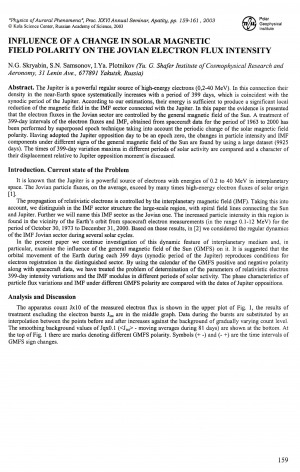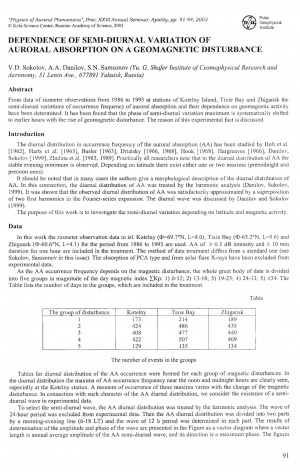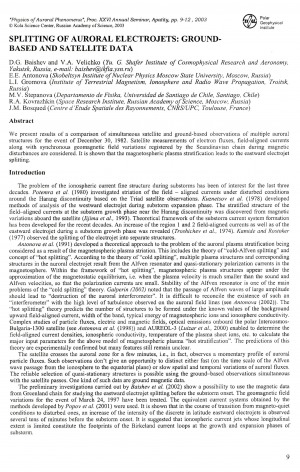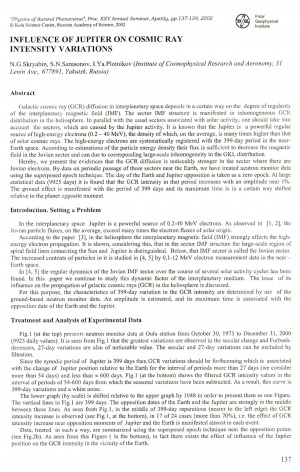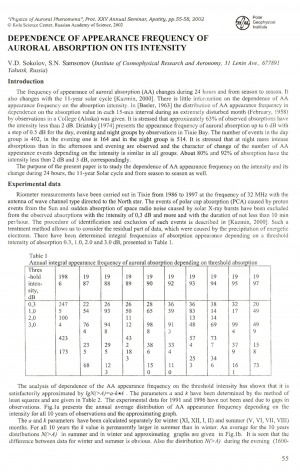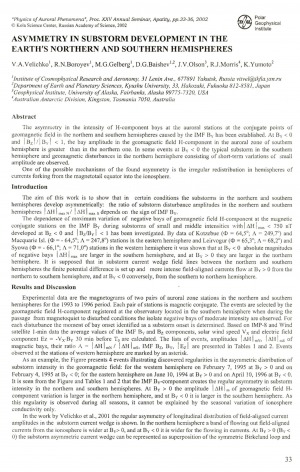Количество страниц: 3 с.
Ammosov, P. P. Observations of short-term waves with an all sky camera in the infrared oh brightness over Yakutsk / P. P. Ammosov, G. A. Gavrilyeva // Physics of auroral phenomena : proceedings of the 26th annual seminar, 25 -28 February 2003. – 2003. – P. 179-181.
Количество страниц: 3 с.
Skryabin, N. G. Influence of a change in solar magnetic field polarity on the Jovian electron flux intensity / N. G. Skryabin, S. N. Samsonov, I. Ya. Plotnikov // Physics of auroral phenomena : proceedings of the 26th annual seminar, 25 - 28 February 2003. – 2003. – P. 159-161.
Количество страниц: 3 с.
Sokolov, V. D. The dynamics of auroral absorption parameters in the 22nd solar activity cycle / V. D. Sokolov, S. N. Samsonov // Physics of auroral phenomena : proceedings of the 26th annual seminar, 25 - 28 February 2003. – 2003. – P. 95-97.
Количество страниц: 4 с.
Sokolov, V. D. Dependence of semi-diurnal variation of auroral absorption on a geomagnetic disturbance / V. D. Sokolov, A. A. Danilov, S. N. Samsonov // Physics of auroral phenomena : proceedings of the 26th annual seminar, 25 - 28 February 2003. – 2003. – P. 91-94.
Количество страниц: 4 с.
Effect of Bγ IMF in substorm current wedge formation / V. A. Velichko, R. N. Boroev, I. Ya. Plotnikov, D. G. Baishev // Physics of auroral phenomena : proceedings of the 26th annual seminar, 25 - 28 February 2003. – 2003. – P. 45-48.
Количество страниц: 3 с.
Splitting of auroral electrojets: ground-based and satellite data / D. G. Baishev, V. A. Velichko, E. E. Antonova, L. I. Gromova, M. V. Stepanova, R. A. Kovrazhkin, J. M. Bosqued // Physics of auroral phenomena : proceedings of the 26th annual seminar, 25 - 28 February 2003. – 2003. – P. 9-11.
Количество страниц: 4 с.
Skryabin, N. G. Influence of Jupiter on cosmic ray intensity variations / N. G. Skryabin, S. N. Samsonov, I. Ya. Plotnikov // Physics of auroral phenomena : proceedings of the 25th annual seminar, Apatity, 26 February – 1 March 2002. – 2002. – P. 137-139.
Количество страниц: 4 с.
Sokolov, V. D. Dependence of appearance frequency of auroral absorption on its intensity / V. D. Sokolov, S. N. Samsonov // Physics of auroral phenomena : proceedings of the 25th annual seminar, Apatity, 26 February – 1 March 2002. – 2002. – P. 55-58.
Количество страниц: 4 с.
Formation of polarization jet during injection of ions into the inner magnetosphere / V. L. Khalipov, Yu. I. Galperin, A. E. Stepanov, E. D. Bondar // Physics of auroral phenomena : proceedings of the 25th annual seminar, Apatity, 26 February – 1 March 2002. – 2002. – P. 43-46.
DOI: 10.1016/S0273-1177(03)00016-4
Количество страниц: 4 с.
Asymmetry in substorm development in the earth's northern and southern hemispheres / V. A. Velichko, R. N. Boroyev, M. G. Gelberg, D. G. Baishev, J. V. Olson, R. J. Morris, K. Yumoto // Physics of auroral phenomena : proceedings of the 25th annual seminar, Apatity, 26 February – 1 March 2002. – 2002. – P. 33-36.

